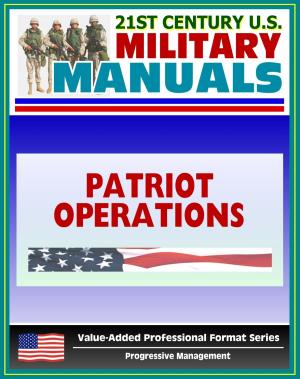World War II Japanese American Internment Reports: Final Report of Army General DeWitt on Japanese Evacuation From the West Coast 1942, Rationale and Details of Relocation Process, Nisei and Issei
Nonfiction, History, Asian, Japan, Military, World War II| Author: | Progressive Management | ISBN: | 9781311358127 |
| Publisher: | Progressive Management | Publication: | December 1, 2015 |
| Imprint: | Smashwords Edition | Language: | English |
| Author: | Progressive Management |
| ISBN: | 9781311358127 |
| Publisher: | Progressive Management |
| Publication: | December 1, 2015 |
| Imprint: | Smashwords Edition |
| Language: | English |
Professionally converted for accurate flowing-text e-book format reproduction, this is the complete official version of the famous DeWitt report on the World War II Japanese Internment program. The military, under President Franklin D. Roosevelt, called the relocation and internment program an evacuation. This report is controversial because it states the rationale and justifications offered by the American government for the program.
The Foreword by Henry Stimson, Secretary of War, states:
"This volume constitutes a comprehensive report on the evacuation from West Coast areas of persons of Japanese ancestry carried out by the Army in the interests of military security during the spring of 1942. The considerations which led to evacuation as well as the mechanics by which it was achieved, are set forth in detail. Great credit, in my opinion, is due General DeWitt and the Army for the humane yet efficient manner in which this difficult task was handled. It was unfortunate that the exigencies of the military situation were such as to require the same treatment for all persons of Japanese ancestry, regardless of their individual loyalty to the United States. But in emergencies, where the safety of the Nation is involved, consideration of the rights of individuals must be subordinated to the common security."
CHAPTER I - Action Under Alien Enemy Proclamations * CHAPTER II - Need for Military Control and for Evacuation * CHAPTER III - Establishment of Military Control - Executive Order No. 9066 * CHAPTER IV - The Emergence of Controlled Evacuation * CHAPTER V - Separation of Jurisdiction Over Evacuation and Relocation * CHAPTER VI - The Evacuation Method * CHAPTER VII - Organization and Functions of Civil Affairs Division, General Staff, and Wartime Civil Control Administration and Other Agencies * CHAPTER VIII - Development and Execution of the Evacuation Plan * CHAPTER X - Operation of Civil Control Stations Protection of Evacuees and Their Families * CHAPTER XI - Protection of Property of the Evacuees * CHAPTER XII - Deferments and Exemptions From Evacuation * CHAPTER XIII - Assembly Center Location, Construction and Equipment * CHAPTER XIV - Housing, Feeding and Clothing * CHAPTER XV - Medical Care and Sanitation CHAPTER XIV - Housing, Feeding and Clothing * CHAPTER XVI - Employment of Evacuees in Assembly Centers * CHAPTER XVII - Education, Recreation, Religion and Assembly Center Newspapers * CHAPTER XVIII - Assembly Center Security * CHAPTER XIX - Administration of Assembly Centers * CHAPTER XX - War Relocation Authority * CHAPTER XXI - The Construction and Equipment of Relocation Centers * CHAPTER XXII - Transfer of Evacuees From Assembly to Relocation Centers * CHAPTER XXIII - Curfew and Travel Control * CHAPTER XXIV - Repatriation of Japanese * CHAPTER XXV - Public Relations Summary * CHAPTER XXVI - Inspection of Wartime Civil Control Administration Operations * CHAPTER XXVII - Fiscal Summary * CHAPTER XXVIII - Statistical Summary
"The report comprises nine Parts and reference matter. In Part I, I have traced the developments which led to the issuance by the President of Executive Order No. 9066, establishing military control over the Pacific Coast. The military necessity for the specific action reported is outlined in Chapter II. Part II, Chapters IV to VI, inclusive, presents a resume of the evacuation method. In these chapters the means provided to protect the persons, the property and the health of evacuees are described. In succeeding Parts a more detailed account of each phase of the operation is found. Part III describes the military organization established to accomplish the evacuation. Part IV, Chapters VIII to XII cover evacuation operations.
Professionally converted for accurate flowing-text e-book format reproduction, this is the complete official version of the famous DeWitt report on the World War II Japanese Internment program. The military, under President Franklin D. Roosevelt, called the relocation and internment program an evacuation. This report is controversial because it states the rationale and justifications offered by the American government for the program.
The Foreword by Henry Stimson, Secretary of War, states:
"This volume constitutes a comprehensive report on the evacuation from West Coast areas of persons of Japanese ancestry carried out by the Army in the interests of military security during the spring of 1942. The considerations which led to evacuation as well as the mechanics by which it was achieved, are set forth in detail. Great credit, in my opinion, is due General DeWitt and the Army for the humane yet efficient manner in which this difficult task was handled. It was unfortunate that the exigencies of the military situation were such as to require the same treatment for all persons of Japanese ancestry, regardless of their individual loyalty to the United States. But in emergencies, where the safety of the Nation is involved, consideration of the rights of individuals must be subordinated to the common security."
CHAPTER I - Action Under Alien Enemy Proclamations * CHAPTER II - Need for Military Control and for Evacuation * CHAPTER III - Establishment of Military Control - Executive Order No. 9066 * CHAPTER IV - The Emergence of Controlled Evacuation * CHAPTER V - Separation of Jurisdiction Over Evacuation and Relocation * CHAPTER VI - The Evacuation Method * CHAPTER VII - Organization and Functions of Civil Affairs Division, General Staff, and Wartime Civil Control Administration and Other Agencies * CHAPTER VIII - Development and Execution of the Evacuation Plan * CHAPTER X - Operation of Civil Control Stations Protection of Evacuees and Their Families * CHAPTER XI - Protection of Property of the Evacuees * CHAPTER XII - Deferments and Exemptions From Evacuation * CHAPTER XIII - Assembly Center Location, Construction and Equipment * CHAPTER XIV - Housing, Feeding and Clothing * CHAPTER XV - Medical Care and Sanitation CHAPTER XIV - Housing, Feeding and Clothing * CHAPTER XVI - Employment of Evacuees in Assembly Centers * CHAPTER XVII - Education, Recreation, Religion and Assembly Center Newspapers * CHAPTER XVIII - Assembly Center Security * CHAPTER XIX - Administration of Assembly Centers * CHAPTER XX - War Relocation Authority * CHAPTER XXI - The Construction and Equipment of Relocation Centers * CHAPTER XXII - Transfer of Evacuees From Assembly to Relocation Centers * CHAPTER XXIII - Curfew and Travel Control * CHAPTER XXIV - Repatriation of Japanese * CHAPTER XXV - Public Relations Summary * CHAPTER XXVI - Inspection of Wartime Civil Control Administration Operations * CHAPTER XXVII - Fiscal Summary * CHAPTER XXVIII - Statistical Summary
"The report comprises nine Parts and reference matter. In Part I, I have traced the developments which led to the issuance by the President of Executive Order No. 9066, establishing military control over the Pacific Coast. The military necessity for the specific action reported is outlined in Chapter II. Part II, Chapters IV to VI, inclusive, presents a resume of the evacuation method. In these chapters the means provided to protect the persons, the property and the health of evacuees are described. In succeeding Parts a more detailed account of each phase of the operation is found. Part III describes the military organization established to accomplish the evacuation. Part IV, Chapters VIII to XII cover evacuation operations.















